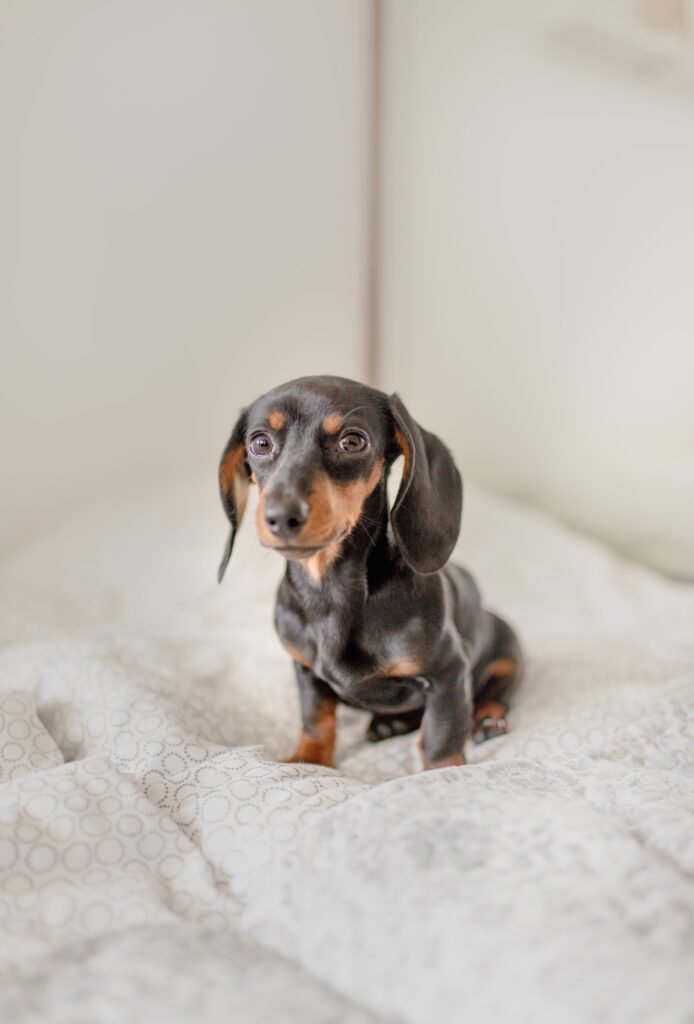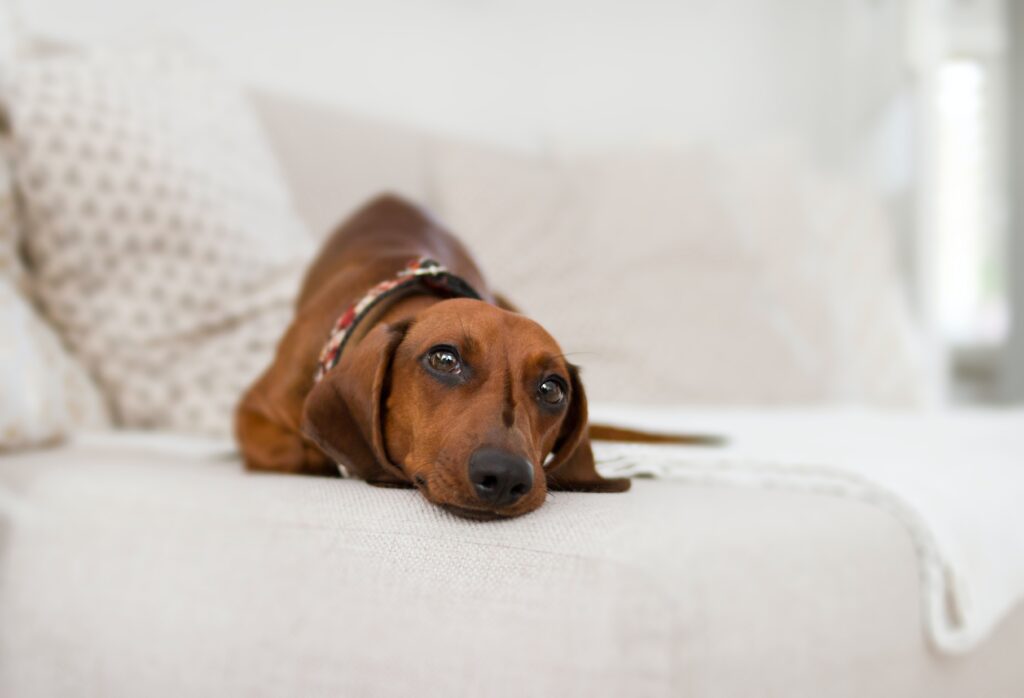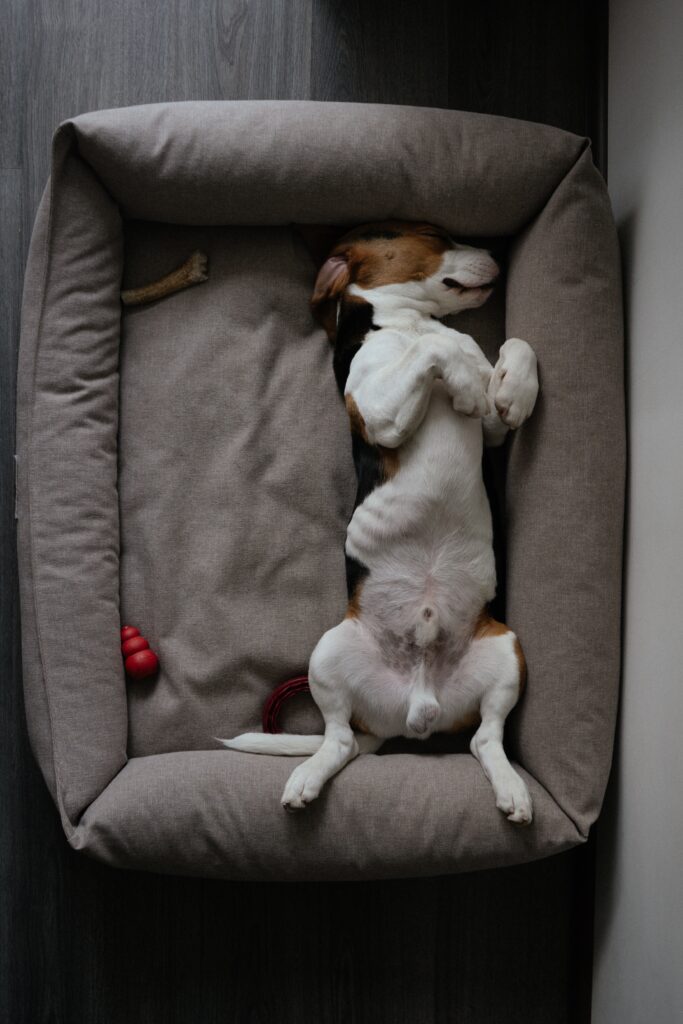Dog owners know that keeping their furry friends’ beds clean is essential for their health and wellbeing. However, accidents can happen, and urine stains on the dog bed are not uncommon.
So, how can you wash a dog bed with urine effectively?
The answer is simple: first, remove any solid waste and blot the urine with a clean towel. Then, wash the bed in hot water with a pet-safe detergent and add half a cup of white vinegar to the rinse cycle. Finally, dry the bed thoroughly, preferably in direct sunlight.

But there are some essential things to keep in mind while washing your dog’s bed. Not all detergents are pet-friendly, and certain fabrics require special care.
In this article, we will explore the best ways to clean different types of dog beds and provide tips from expert veterinarians on how to keep your pet’s bed hygienic and comfortable.
So, let’s dive in and learn how to keep your furry friend’s bed fresh and clean.
Before You Begin
It is important to have all the necessary supplies on hand before attempting to clean your best friend’s bed of urine.
The strength of the odor and how long the urine has been absorbed into the fabric will determine the supplies needed. Here are some ways to wash the urine out of your dog’s bed:
- Rubber gloves
- Face mask
- Vinegar
- Baking soda
- Pet safe laundry detergent
- Enzymatic stain remover
- Scrubbing brush (if not using a washing machine)
Now let see method 1.
Method:1 The 11 Steps to Get Urine Out of a Dog Bed
1. Read the Care Label on the Dog Bed
The first step in getting urine out of a dog bed is to read the care label on the bed. The care label should be located on the bed and will provide important information on how to properly clean and care for the bed.
Reading the care label is crucial because different dog beds may require different cleaning methods or may have specific limitations.
For example, some beds may not be machine-washable or may require special handling.
If you don’t follow the care label instructions, you may accidentally damage the bed or reduce its lifespan.
It’s important to pay attention to any special cleaning instructions or limitations to ensure that you don’t void the bed’s warranty or cause any harm to your pet.
If the care label is missing or unreadable, you can usually find cleaning instructions on the manufacturer’s website or by contacting their customer support.
Overall, taking the time to read the care label is an important first step in properly cleaning your dog’s bed and ensuring its longevity.
2. Move the Bed to an Appropriate Workspace
The second step in getting urine out of a dog bed is to move the bed to an appropriate workspace. This step is important to ensure that you have enough space to work on the bed and to avoid any mess or damage to your flooring.
When choosing a workspace, look for an area that is well-ventilated and has enough room to comfortably work on the bed. You may want to consider placing a tarp or plastic sheet underneath the bed to protect your flooring from any spills or drips.
Make sure that you have all the necessary cleaning supplies within reach before you begin cleaning the bed. This can include enzymatic cleaners, mild detergents, vinegar, baking soda, and any other tools or supplies recommended by the care label or manufacturer.
It’s also a good idea to wear gloves and protective clothing to avoid contact with any urine or cleaning products. Once you have your workspace set up and your supplies ready, you’re ready to move on to the next step in the process.
3. Pre-treat the External Cover With an Enzymatic Product
The third step in getting urine out of a dog bed is to pre-treat the external cover with an enzymatic product.
Enzymatic cleaners are specially designed to break down the proteins in urine, which can help eliminate odors and stains.
To pre-treat the cover, apply the enzymatic cleaner to the affected areas of the cover, making sure to saturate the fabric completely. You may want to use a spray bottle to apply the cleaner evenly and avoid over-saturating the fabric.
Once you have applied the enzymatic cleaner, let it sit on the cover for the recommended time, which is usually around 10-15 minutes. This will give the enzymes time to break down the proteins in the urine and eliminate any odors.
After the recommended time has passed, you can either wash the cover in the washing machine or proceed to the next step in the process, depending on the severity of the urine stain and odor.
In general, pre-treating the cover with an enzymatic cleaner is a crucial step in eliminating urine stains and odors from your dog’s bed.
4. If You Can, Take Off the Covers
The fourth step in getting urine out of a dog bed is to take off the covers if possible. If the bed has removable covers, it’s recommended to remove them before continuing with the cleaning process.
This will make it easier to clean the covers thoroughly and ensure that any urine or odor is completely eliminated.
To remove the covers, locate the fasteners or zippers that are holding them in place and carefully detach them from the bed.

If the covers are attached with zippers, make sure to unzip them completely before removing the covers to avoid any damage to the zipper or fabric.
Once the covers are removed, you can proceed to the next step in the process, which is soaking the dog bed. If the covers cannot be removed, you can skip this step and proceed with pre-treating the bed with an enzymatic cleaner.
In general, removing the covers from your dog’s bed is a useful step in ensuring that the bed is thoroughly cleaned and any urine or odor is completely eliminated.
However, it’s important to check the care label or manufacturer’s instructions before removing the covers to avoid damaging the bed or the covers.
5. Soak the Dog Bed
The fifth step in getting urine out of a dog bed is to soak the bed. Soaking the bed is an important step in removing any urine and odor that may have penetrated deep into the bed’s foam or filling.
To soak the bed, fill a bathtub or large basin with enough water to fully submerge the bed. Add a mild detergent or enzymatic cleaner to the water and mix well. Then, carefully place the bed in the water, making sure that it is fully submerged.
Let the bed soak in the water for at least 30 minutes, or according to the instructions on the detergent or enzymatic cleaner. During this time, gently agitate the bed with your hands to help loosen any dirt or debris.
After the bed has soaked, drain the water and gently squeeze out any excess water from the bed. Avoid wringing or twisting the bed, as this can damage the foam or filling.
Once you have removed as much water as possible, you can move on to the next step in the process, which is washing the bed and covers.
In general, soaking the bed is an important step in thoroughly cleaning the bed and removing any urine and odor that may be trapped inside.
6. Put the Bed & Covers in the Washing Machine
The sixth step in getting urine out of a dog bed is to put the bed and covers in the washing machine.
Washing the bed and covers in the machine is an important step in removing any remaining urine and odor, and ensuring that the bed is thoroughly cleaned.
Before putting the bed and covers in the washing machine, make sure to check the care label or manufacturer’s instructions.
Some beds may not be suitable for machine washing, and attempting to wash them in the machine could damage the bed.
If the bed and covers are suitable for machine washing, place them in the machine and add a mild detergent or enzymatic cleaner. Use a gentle cycle with cool water to avoid damaging the bed and covers.
Once the cycle is complete, remove the bed and covers from the machine and inspect them for any remaining urine or odor. If necessary, repeat the washing process or move on to the next step in the process, which is washing the bed by hand.
In general, putting the bed and covers in the washing machine is an important step in thoroughly cleaning the bed and ensuring that any urine and odor is eliminated.
However, it’s important to check the care label or manufacturer’s instructions before machine washing to avoid damaging the bed or covers.
7. Wash Your Dog Bed By Hand
The seventh step in getting urine out of a dog bed is to wash the bed by hand. Washing the bed by hand can help to remove any remaining urine and odor that may not have been eliminated in the previous steps.
To wash the bed by hand, fill a basin or bathtub with cool water and add a mild detergent or enzymatic cleaner.
Place the bed in the water and use your hands to gently agitate the water and work the detergent into the fabric. Pay special attention to any areas that may have been heavily soiled or have a strong odor.
After washing the bed, drain the water and refill the basin or bathtub with clean water. Rinse the bed thoroughly to remove any soap residue. Repeat this process as necessary until the water runs clear and there is no remaining soap residue.
Once you have finished washing the bed, gently squeeze out any excess water. Avoid wringing or twisting the bed, as this can damage the foam or filling. Then, move on to the next step in the process, which is adding vinegar (optional).
In general, washing the bed by hand can help to ensure that any remaining urine and odor is eliminated and that the bed is thoroughly cleaned.
8. Add Vinegar (Optional)
The eighth step in getting urine out of a dog bed is to add vinegar, which is an optional step but can be helpful in removing any remaining urine odor. Vinegar is a natural cleaning agent and can help to neutralize the ammonia in urine.
To add vinegar to the cleaning process, mix one part vinegar with one part water in a spray bottle.
Spray the solution over the bed, focusing on any areas that may have been heavily soiled or have a strong odor. Allow the vinegar solution to sit on the bed for 5-10 minutes.
After the vinegar solution has been allowed to sit on the bed, rinse the bed thoroughly with cool water to remove any vinegar residue. Be sure to rinse the bed well, as leaving vinegar residue on the bed can cause skin irritation in dogs.
After rinsing the bed, gently squeeze out any excess water and move on to the next step in the process, which is to rinse the bed thoroughly.
In general, adding vinegar to the cleaning process can help to eliminate any remaining urine odor and is a natural cleaning agent that is safe for dogs.
9. Rinse the Dog Bed Thoroughly
The ninth step in getting urine out of a dog bed is to rinse the bed thoroughly. After the bed has been soaked and washed, it is important to make sure that all of the cleaning solution and urine has been completely removed from the bed.

To rinse the bed, first fill a large sink or bathtub with cool water. Place the bed in the water and gently agitate the bed to help remove any remaining cleaning solution or urine.
Drain the water and refill the sink or bathtub with clean water. Repeat the process until the water runs clear and there is no more soap or urine residue coming out of the bed.
Once the bed has been thoroughly rinsed, gently squeeze out any excess water and move on to the next step in the process, which is to add baking soda to the rinse cycle (optional).
Thoroughly rinsing the dog bed is important to ensure that all cleaning solution and urine has been removed from the bed, which will help to eliminate any remaining odors and prevent skin irritation in dogs.
10. Add Baking Soda to the Rinse Cycle (Optional)
The tenth step in getting urine out of a dog bed is to add baking soda to the rinse cycle, which is an optional step but can be very effective in removing any remaining odors from the bed.
To add baking soda to the rinse cycle, first make sure that the bed is thoroughly rinsed and there is no more soap or urine residue left in the bed.
Then, start the rinse cycle on the washing machine and wait until the water has filled up the machine. Once the machine is filled with water, add half a cup to a full cup of baking soda to the water.
The baking soda will help to neutralize any remaining odors in the bed and leave it smelling fresh and clean. It will also help to soften the fabric of the bed and make it feel more comfortable for your dog.
After adding the baking soda to the rinse cycle, let the washing machine complete the cycle as normal. Once the cycle is finished, remove the bed and prepare to dry it in the next step.
Adding baking soda to the rinse cycle can be a very effective way to remove any remaining odors from a dog bed, but it is important to make sure that the bed is thoroughly rinsed before adding the baking soda to prevent any soap or urine residue from reacting with the baking soda.
11. Dry the Bed & Covers
The eleventh and final step in getting urine out of a dog bed is to dry the bed and covers. There are a few different methods you can use to dry the bed and covers, depending on what supplies you have available.
One option is to hang the bed and covers outside on a clothesline to dry in the sun. This can be a great way to remove any remaining odors and bacteria from the bed, as the sun will naturally disinfect and freshen the fabric.
However, if you live in a humid climate or if it’s raining outside, this may not be the best option.
Another option is to put the bed and covers in the dryer on a low heat setting.
It’s important to make sure that the bed and covers are completely dry before using them again, as any moisture left in the fabric can cause mold and mildew to grow.
If you have a large dog bed that won’t fit in a standard-sized dryer, you may need to use a commercial-sized dryer at a laundromat.
Another option is to use a fan to help dry the bed and covers more quickly.
It’s important to be patient and make sure the bed and covers are completely dry before using them again.
This will help to prevent any remaining odors from developing and keep your dog healthy and happy.
In summary, drying the bed and covers is the final step in getting urine out of a dog bed, and there are several different methods you can use to ensure that the bed and covers are completely dry and free of any remaining odors.
12. Air Your Dog Bed Out (Optional)
Step 12, “Air Your Dog Bed Out (Optional)”, is an additional step that you can take to help remove any remaining odors from the bed.
After washing and drying the bed, you can place it outside in a well-ventilated area to air out. This step is optional, but it can help to further freshen up the bed and remove any lingering odors.
To air out your dog bed, choose a location that is protected from the elements but still has good air flow, such as a covered patio or garage. Lay the bed out on a clean surface and let it sit for several hours or overnight.
If possible, flip the bed over halfway through the airing out process to ensure that both sides are exposed to the fresh air.
After airing out your dog bed, give it a final check to make sure that there are no remaining odors.
If the bed still smells strongly of urine, you may need to repeat some of the previous steps or consider replacing the bed altogether.
Method 2: The 6 Steps to Washing a Dog Bed with Urine in It
1. Soak Up Residual Urine
The first step in washing a dog bed with urine in it is to soak up any residual urine that may be on the surface. This can be done using paper towels, a clean cloth, or even a wet/dry vacuum if you have one available.
It’s important to remove as much urine as possible before beginning the washing process, as this will make it easier to fully clean and deodorize the bed.
Additionally, leaving urine to sit for an extended period of time can lead to unpleasant odors and potential staining.
When soaking up the urine, be sure to press firmly into the bed to absorb as much liquid as possible. It may be helpful to repeat this process several times to ensure that you have removed as much urine as possible.
Once you have soaked up as much urine as possible, dispose of the paper towels or cloth and move on to the next step in the washing process.
2. Remove Cover, if Applicable
The second step in washing a dog bed with urine in it is to remove the cover, if applicable.
Many dog beds come with removable covers that can be washed separately from the rest of the bed.
If your dog bed has a removable cover, carefully remove it and set it aside to be washed separately.
Be sure to check the care label on the cover for specific washing instructions.
Removing the cover allows for a more thorough cleaning of the entire bed, as you can wash the cover separately and focus on cleaning and deodorizing the interior of the bed.
If your dog bed does not have a removable cover, you can skip this step and move on to the next step in the washing process.
3. Saturate the Urine Spots in White Vinegar
The third step to washing a dog bed with urine in it is to saturate the urine spots in white vinegar. White vinegar is a natural and effective cleaning agent that can help neutralize the odor of urine and break down any remaining stains.
To do this, mix equal parts of white vinegar and water in a spray bottle and saturate the urine spots on the dog bed.
Make sure to cover all the affected areas thoroughly. Allow the vinegar solution to sit for about 10-15 minutes to penetrate the fabric and work its magic.
4. Soak the Fabric
The fourth step to washing a dog bed with urine in it is to soak the fabric. After saturating the urine spots with white vinegar, the next step is to soak the fabric in cold water for at least 30 minutes.
This will help to loosen up any remaining urine and lift it out of the fabric. It is important to use cold water, as hot water can set the stain and make it more difficult to remove.

If the dog bed is too large to soak in a container or bathtub, it can be sprayed down with a hose outside.
5. Wash Thoroughly
After soaking the fabric, it’s time to wash it thoroughly. You can use a mild detergent that’s safe for your dog’s skin and health.
You can also add some baking soda to the washing machine to help neutralize any remaining odors. Make sure to use the appropriate washing cycle and temperature for the fabric type and the level of soiling.
Once the wash cycle is complete, you can either air dry the bed or put it in the dryer on a low heat setting.
6. Air Dry or Tumbled as Directed
The sixth step in washing a dog bed with urine in it is to air dry or tumble dry the bed as directed on the care label.
Once the bed has been washed, it is important to dry it thoroughly before using it again to prevent mold and mildew from forming.
If the care label allows for tumble drying, use a low heat setting and check the bed frequently to prevent overheating or shrinking.
If air drying is recommended, hang the bed in a well-ventilated area away from direct sunlight or heat sources until completely dry.
It is important to ensure that the bed is completely dry before using it again to prevent any unpleasant odors from developing.
Preventing Urinating on Dog Beds
Puppies
Puppies can often have accidents on their bedding while they are being potty trained. To prevent this, it is important to establish a consistent routine for taking the puppy outside to go potty.
This means taking the puppy out first thing in the morning, after meals, and before bedtime.
It can also be helpful to restrict access to the rest of the house until the puppy is fully trained. This means keeping the puppy in a designated area, such as a crate or playpen, when unsupervised.
Providing plenty of toys and chew items can also help prevent the puppy from chewing on and potentially urinating on their bedding out of boredom or anxiety.
If accidents do happen, it is important to clean them up promptly with an enzymatic cleaner designed specifically for pet urine. This will help remove the scent and discourage the puppy from repeating the behavior in the same spot.
Seniors/Health Issues
When it comes to seniors or dogs with health issues, preventing urination on dog beds may require some additional steps. Here are some tips:
- Frequent potty breaks: Senior dogs or those with health issues may have difficulty holding their bladder for extended periods. Take them out for potty breaks more frequently to avoid accidents.
- Easy access to potty area: If your dog has mobility issues, ensure that they have easy access to the potty area. This can be achieved by creating a ramp or providing a pee pad nearby.
- Use a waterproof dog bed cover: A waterproof dog bed cover can protect the bed from urine and other accidents. It can also be easily removed and cleaned.
- Choose the right type of bed: Consider choosing a bed with a waterproof liner or one made from materials that are easy to clean.
- Medical treatment: If your dog is experiencing urinary incontinence, it is important to seek medical treatment from a veterinarian. There may be medications or other treatments that can help manage the condition.
- Comfort and hygiene: Keep your dog’s bed clean and comfortable. Regular washing and disinfecting can help maintain hygiene and prevent any discomfort or odor.
Well, now let;s move to some related faq’s.
Frequently Asked Questions
Is It Okay to Wash the Dog Bed in the Machine?
Yes, it is generally okay to wash a dog bed in a washing machine. However, it is important to check the care label of the dog bed to ensure that it is machine washable.
Some dog beds may need to be washed by hand or spot cleaned instead.
Additionally, it is important to use the appropriate settings on the washing machine and to avoid using hot water or harsh detergents that could damage the bed or irritate your dog’s skin.
It may also be a good idea to wash the bed cover separately from other laundry items to prevent the transfer of dirt, hair, or other debris.
How Do You Get the Dog Pee Smell Out of a Dog Bed?
To get rid of the dog pee smell from a dog bed, follow these steps:
- Remove any covers or bedding from the dog bed and soak up as much urine as possible using paper towels or a clean cloth.
- Pre-treat the urine spots with an enzymatic cleaner designed specifically for pet urine.
- Soak the bed in a mixture of warm water and laundry detergent for at least 15 minutes. For tough odors, add 1 cup of white vinegar to the soak.
- Wash the bed in the washing machine on a hot water cycle with an extra rinse.
- Add baking soda to the rinse cycle for extra odor-fighting power.
- Dry the bed thoroughly on a low heat setting in the dryer or let it air dry outside.
- If the smell persists, repeat the above steps or consider replacing the dog bed if it’s very old or has been repeatedly soiled.
It’s important to note that using a regular detergent or fabric softener alone may not be enough to completely eliminate the urine odor. Using enzymatic cleaners and/or odor-neutralizing products is highly recommended.
How Do You Get Pee Out of a Memory Foam Dog Bed?
Cleaning pee out of a memory foam dog bed requires some extra care to avoid damaging the foam. Here are the steps to follow:
- Remove any covers or linens from the memory foam bed.
- Soak up as much urine as possible from the bed using paper towels or a clean cloth. Press down on the spot gently to soak up as much urine as possible.
- Mix one cup of warm water with one cup of white vinegar in a spray bottle.
- Spray the mixture on the urine-stained area of the memory foam bed and allow it to soak in for 5-10 minutes.
- Blot the spot with a clean cloth or paper towel to remove as much moisture as possible.
- Sprinkle baking soda over the spot to absorb any remaining moisture and eliminate any odors.
- Let the baking soda sit for several hours or overnight.
- Vacuum up the baking soda from the bed using a handheld vacuum or the hose attachment of a regular vacuum cleaner.
- If the bed cover is washable, follow the care instructions to wash it in the washing machine.
- Allow the memory foam bed to air dry completely before putting the cover back on or using it again.
Note: Avoid using hot water or a dryer to clean a memory foam dog bed, as this can cause damage to the foam.
Does Washing Our Dog’s Bedding in the Machine Contaminate the Unit for Subsequent Loads of Laundry?
It is unlikely that washing your dog’s bedding in the machine will contaminate the unit for subsequent loads of laundry, as long as you follow proper cleaning procedures.
It’s important to remove any excess hair or debris from the bedding before washing and to use an appropriate amount of detergent and wash at the recommended temperature.
It may also be helpful to run a cycle with just hot water and vinegar after washing your dog’s bedding to help clean and deodorize the machine.
However, if you are concerned about potential contamination, you can also wash your dog’s bedding separately from your other laundry to be extra cautious.
Is Laundry Detergent Safe for Dogs?
Laundry detergents are generally safe for dogs when used as directed. However, some detergents may contain ingredients that can be harmful to dogs if ingested, such as fragrances or certain cleaning agents.
It is important to always use a pet-safe detergent or one recommended by your veterinarian.
Additionally, it is recommended to wash your dog’s bedding separately from your own laundry to avoid any potential cross-contamination or exposure to chemicals.
If you are unsure about the safety of a particular laundry detergent, it is best to consult with your veterinarian for guidance.
What Home Remedy Gets Rid of Dog Pee Smell?
One effective home remedy to get rid of dog pee smell is a mixture of white vinegar and baking soda. To use this remedy, first, blot up any excess urine with paper towels or a clean cloth.
Then, mix one part white vinegar with one part water and saturate the affected area with the solution. Let it sit for a few minutes, then blot up the excess liquid with a clean cloth.
Next, sprinkle baking soda over the area and let it sit for several hours or overnight.
Finally, vacuum up the baking soda and any remaining odor should be gone.
Other remedies include using hydrogen peroxide and dish soap, or a commercial enzymatic cleaner specifically designed for pet urine stains and odors.
Why Does My Dog Pee on the Dog Bed?
There are several reasons why a dog may pee on their bed:
- Medical issues: Dogs with medical problems such as urinary tract infections, bladder stones, and diabetes may experience frequent urination and may not be able to control their bladder.
- Anxiety or stress: Dogs who are anxious or stressed may urinate on their bed as a coping mechanism. This is common in dogs who experience separation anxiety, fear of loud noises, or changes in their environment.
- Marking behavior: Dogs may pee on their bed as a way to mark their territory. This is more common in male dogs who are not neutered.
- Aging: As dogs age, they may experience incontinence, which can cause them to pee on their bed.
It’s important to determine the underlying cause of your dog’s behavior and address it appropriately. If you suspect a medical issue, consult with your veterinarian.
If your dog is exhibiting anxiety or stress, consider consulting with a professional dog trainer or behaviorist.
Is It Normal for Puppies to Wet the Bed?
Yes, it is normal for puppies to wet the bed, especially when they are young and still learning how to control their bladder. Puppies have small bladders and limited control over their bladder muscles, so they need to go to the bathroom frequently.
They may not be able to hold their urine for long periods, which can result in accidents, including wetting their bed. However, with proper training and patience, puppies can learn to control their bladder and avoid accidents.
If your puppy continues to wet the bed despite your efforts to train them, it’s a good idea to consult with a veterinarian to rule out any underlying health issues.
How Do I Stop My Puppy Peeing on Its Bed?
To stop a puppy from peeing on its bed, you can try the following steps:
- Ensure the puppy is getting enough potty breaks: Puppies have small bladders, so they need to go outside to pee often, especially after eating, drinking, and napping. Make sure to take your puppy out regularly.
- Create a designated potty area: Take your puppy to the same spot outside every time to help them associate that area with going potty.
- Supervise your puppy: If your puppy is not fully potty trained, it’s important to supervise them and prevent them from having accidents in the house. Keep them in a crate or a small, enclosed area when you can’t watch them.
- Reward good behavior: Praise and reward your puppy when they pee outside or in their designated potty area.
- Clean up accidents thoroughly: If your puppy has an accident on their bed, clean it up thoroughly with an enzymatic cleaner to remove any lingering odors that might attract them back to the same spot.
- Consider crate training: If your puppy continues to pee on their bed, consider crate training them to help them learn to hold their bladder and keep their sleeping area clean.
Do Dogs Mark Their Beds?
Yes, dogs may mark their beds as a way of claiming it as their own territory. Marking behavior is often associated with male dogs and can be a sign of dominance or insecurity.
However, both male and female dogs may mark their beds or other areas in the house.
It’s important to address marking behavior to prevent it from becoming a habit and causing issues with urine stains and odors in the home.
How Do I Know if My Dog Has a UTI?
There are several signs that your dog may have a urinary tract infection (UTI). These signs may include:
- Frequent urination: If your dog is asking to go outside more often than usual, or if they are having accidents inside, it could be a sign of a UTI.
- Straining to urinate: Your dog may appear to be straining or taking longer than usual to urinate.
- Painful urination: Your dog may cry out or whine when urinating, or they may show signs of discomfort.
- Blood in the urine: If your dog’s urine appears to be pink or red, it may be a sign of blood.
- Strong-smelling urine: If your dog’s urine has a strong, unusual odor, it may be a sign of a UTI.
- Licking the genital area: Your dog may lick their genital area more often than usual, which can be a sign of discomfort.
If you notice any of these signs, it is important to take your dog to the vet for a checkup. The vet will be able to diagnose whether your dog has a UTI and prescribe the appropriate treatment.
Why Should I Invest in a Waterproof Liner for My Dog Bed?
Investing in a waterproof liner for your dog bed can be beneficial for a few reasons. First, it helps protect the mattress or cushion of the dog bed from damage due to accidents or spills, making it last longer.
Second, it can help prevent the growth of mold and mildew, which can be harmful to your dog’s health.
Finally, a waterproof liner can help control odors, making the dog bed more comfortable and hygienic for your furry friend.
Overall, a waterproof liner can be a wise investment to ensure your dog’s bed stays clean, dry, and fresh.
Conclusion
In conclusion, keeping your dog’s bed clean is crucial for their health and happiness. With urine being one of the most common stains on dog beds, it’s important to know how to clean it effectively.
By following the steps outlined in this blog, you can ensure that your furry friend’s bed is free from urine and other stains.
But we want to hear from you! Have you ever had to clean a dog bed with urine?
What methods have you found to be the most effective? Let us know in the comments below!
And remember, a clean bed is a happy bed, so make sure to wash your dog’s bed regularly to keep them healthy and comfortable.






